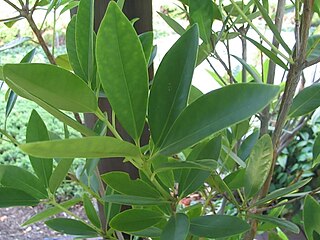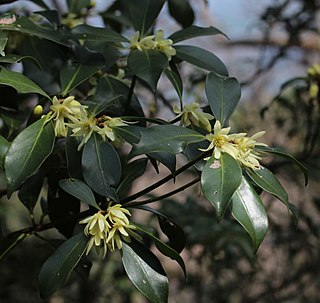
Anise, also called aniseed or rarely anix is a flowering plant in the family Apiaceae native to the eastern Mediterranean region and Southwest Asia.

Illicium verum is a medium-sized evergreen tree native to northeast Vietnam and South China. It is a spice that closely resembles anise in flavor and is obtained from the star-shaped pericarps of the fruit of I. verum which are harvested just before ripening. Star anise oil is a highly fragrant oil used in cooking, perfumery, soaps, toothpastes, mouthwashes, and skin creams. Until 2012, when they switched to using a bacterial source, Roche Pharmaceuticals used up to 90% of the world's annual star anise crop to produce shikimic acid, a chemical intermediate used in the synthesis of oseltamivir (Tamiflu).

Austrobaileyales is an order of flowering plants consisting of about 100 species of woody plants growing as trees, shrubs and lianas. The best-known species is Illicium verum, commonly known as star anise. The order belongs to the group of basal angiosperms, the ANA grade, which diverged earlier from the remaining flowering plants. Austrobaileyales is sister to all remaining extant angiosperms outside the ANA grade.
Shikimic acid, more commonly known as its anionic form shikimate, is a cyclohexene, a cyclitol and a cyclohexanecarboxylic acid. It is an important biochemical metabolite in plants and microorganisms. Its name comes from the Japanese flower shikimi, from which it was first isolated in 1885 by Johan Fredrik Eykman. The elucidation of its structure was made nearly 50 years later.

Illicium anisatum, with common names Japanese star anise, Aniseed tree, and sacred Anise tree, known in Japan as shikimi, is a tree closely related to the Chinese star anise. Since it is highly toxic, the fruit is not edible; instead, the dried and powdered leaves are burned as incense in Japan. Its branches and evergreen leaves are considered highly sacred by Japanese Buddhists due to aversion from insects and their ability to remain fresh after pruning.

Illicium is a genus of flowering plants treated as part of the family Schisandraceae, or alternately as the sole genus of the Illiciaceae. It has a disjunct distribution, with most species native to eastern Asia and several in parts of North America, including the southeastern United States, Mexico, and the Caribbean. General common names include star anise and anisetree. The genus name comes from the Latin illicere.

Illiciaceae A.C.Sm. was a family of flowering plants recognized in a number of systems of plant taxonomy. The Illiciaceae is not recognized as a distinct family by the APG III system of plant taxonomy, the most well accepted system in use today.

Augustine Henry was a British-born Irish plantsman and sinologist. He is best known for sending over 15,000 dry specimens and seeds and 500 plant samples to Kew Gardens in the United Kingdom. By 1930, he was a recognised authority and was honoured with society membership in Belgium, Czechoslovakia, Finland, France, and Poland. In 1929 the Botanical Institute of Peking dedicated to him the second volume of Icones plantarum Sinicarum, a collection of plant drawings. In 1935, John William Besant was to write: 'The wealth of beautiful trees and flowering shrubs which adorn gardens in all temperate parts of the world today is due in a great measure to the pioneer work of the late Professor Henry'.
Gymnosphaera henryi, synonyms Alsophila henryi and Cyathea henryi, is a species of tree fern native to eastern India and the Himalayas, Indochina, and southern China, where it grows submontane and montane forest at an elevation of 600–1200 m. The trunk of this plant is erect and may be 5–7 m tall or more. Fronds are bi- or tripinnate and usually 2–3 m in length. The rachis is smooth and dark, but occasionally has a few scattered scales. The stipe also has these scales. The scales are either small and pale with irregular fringed edges, or large and dark with a paler margin. Sori are borne on minor veins and lack indusia.
Henryi, a new Latin adjective used for any of several naturalists named Henry, may refer to:
Illicium tenuifolium is a species of flowering plant in the family Schisandraceae. It is a tree native to Indo-China and Peninsular Malaysia. It grows in tropical forests, including cloud forests.
Illicium ternstroemioides is a species of tree in the family Schisandraceae, or alternately, the Illiciaceae. It is native to northern Vietnam and Hainan Island in China.

Illicium floridanum is an evergreen shrub native to the Gulf Coast area of the Southern United States, from Florida to Louisiana.

Illicium parviflorum, commonly known as yellow anisetree, yellow-anise, swamp star-anise, and small anise tree, is a species of flowering plant in the family Schisandraceae, or alternately, the Illiciaceae. It is native to Florida in the United States. It historically occurred in Georgia as well, but it has been extirpated from the state.

Emmenopterys henryi is a species of flowering plant in the family Rubiaceae. It is found in the temperate parts of central and southern China and in Vietnam. It is a deciduous tree with opposite leaves and can attain heights of 45 m and grow to be 1000 years old. The epithet is named after the Irish botanist and sinologist Augustine Henry. The trees may not flower until they are 30–100 years old, and flowering seems to be triggered by a long hot summer. Many inflorescences are accompanied by a large white bract.

Merrilactone A is one of the four sesquiterpenes that were newly discovered from the fruit of Illicium merrillianum in 2000. Members of the genus Illicium include Chinese star anise, widely used as a spice for flavouring food and beverages, and also poisonous plants such as Japanese star anise. Chemical studies of Illicium have developed rapidly over the last 20 years, and merrilactone A has been shown to have neurotrophic activity in fetal rat cortical neuron cultures. This has led researchers to believe that Merrilactone A may hold therapeutic potential in the treatment of neuro-degenerative diseases such as Alzheimer's disease and Parkinson's disease.
Star anise refers to Illicium verum Chinese star anise, and the spice derived from it. It can also refer to related poisonous plants:

Corymbia henryi, commonly known as large-leaved spotted gum, is a species of small to medium-sized tree that is endemic to north-eastern Australia. It has smooth, mottled bark, lance-shaped adult leaves, flower buds in groups of three, white or lemon yellow flowers and barrel-shaped to urn-shaped fruit.
Iris henryi is a beardless rhizomatous iris. It is in the genus Iris, subgenus Limniris and in the series Chinenses of the genus, from China. It has thin green leaves, short stem and light-blue, to creamy-white or pale yellow flowers.

Castanea henryi, Henry chestnut, Henry's chestnut, or Chinese chinquapin, pearl chestnut, and in Chinese: 锥栗, zhui li, is a species of chestnut native to south-central and southeast China. A tree reaching 30 m, it is a source of good timber, but has smaller nuts than its size might suggest. Like its close relative Castanea mollissima it is widely cultivated in China, and quite a few varieties have been developed in recent times.













